Solar eclipse of August 31, 1932
A total solar eclipse occurred on August 31, 1932. A solar eclipse occurs when the Moon passes between Earth and the Sun, thereby totally or partly obscuring the image of the Sun for a viewer on Earth. A total solar eclipse occurs when the Moon's apparent diameter is larger than the Sun's, blocking all direct sunlight, turning day into darkness. Totality occurs in a narrow path across Earth's surface, with the partial solar eclipse visible over a surrounding region thousands of kilometres wide. Totality was visible from Northwest Territories (today's Northwest Territories and Nunavut) and Quebec in Canada, and northeastern Vermont, New Hampshire, southwestern Maine, northeastern tip of Massachusetts and northeastern Cape Cod in the United States.
| Solar eclipse of August 31, 1932 | |
|---|---|
 Map | |
| Type of eclipse | |
| Nature | Total |
| Gamma | 0.8307 |
| Magnitude | 1.0257 |
| Maximum eclipse | |
| Duration | 105 sec (1 m 45 s) |
| Coordinates | 54.5°N 79.5°W |
| Max. width of band | 155 km (96 mi) |
| Times (UTC) | |
| Greatest eclipse | 20:03:41 |
| References | |
| Saros | 124 (50 of 73) |
| Catalog # (SE5000) | 9357 |

Related eclipses
Solar eclipses 1931–1935
This eclipse is a member of a semester series. An eclipse in a semester series of solar eclipses repeats approximately every 177 days and 4 hours (a semester) at alternating nodes of the Moon's orbit.[1]
| Solar eclipse series sets from 1931–1935 | |||||
|---|---|---|---|---|---|
| Descending node | Ascending node | ||||
| 114 | September 12, 1931 Partial |
119 | March 7, 1932 Annular | ||
| 124 | August 31, 1932 Total |
129 | February 24, 1933 Annular | ||
| 134 | August 21, 1933 Annular |
139 | February 14, 1934 Total | ||
| 144 | August 10, 1934 Annular |
149 | February 3, 1935 Partial | ||
| 154 | July 30, 1935 Partial | ||||
Saros 124
Solar saros 124, repeating every about 18 years and 11 days, contains 73 events. The series started with partial solar eclipse on March 6, 1049. It contains total eclipses from June 12, 1211, to September 22, 1968, and a hybrid solar eclipse on October 3, 1986. The series ends at member 73 as a partial eclipse on May 11, 2347. The longest total eclipse occurred on May 3, 1734, at 5 minutes and 46 seconds.[2]
| Series members 43–59 occur between 1801 and 2100: | ||
|---|---|---|
| 43 | 44 | 45 |
 June 16, 1806 |
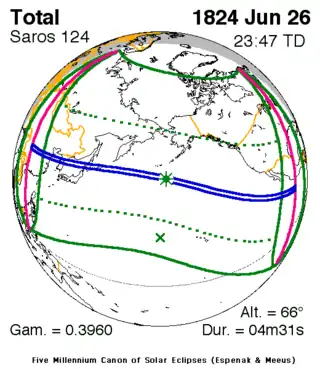 June 26, 1824 |
 July 8, 1842 |
| 46 | 47 | 48 |
 July 18, 1860 |
 July 29, 1878 |
 August 9, 1896 |
| 49 | 50 | 51 |
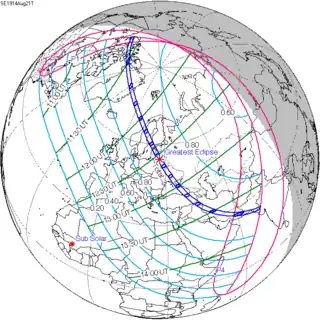 August 21, 1914 |
 August 31, 1932 |
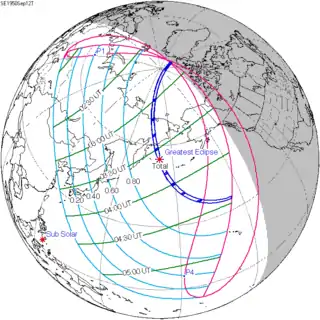 September 12, 1950 |
| 52 | 53 | 54 |
 September 22, 1968 |
 October 3, 1986 |
 October 14, 2004 |
| 55 | 56 | 57 |
 October 25, 2022 |
 November 4, 2040 |
 November 16, 2058 |
| 58 | 59 | |
 November 26, 2076 |
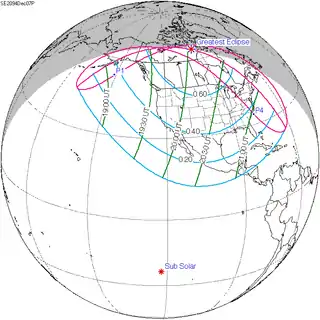 December 7, 2094 | |
Inex series
This eclipse is a part of the long period inex cycle, repeating at alternating nodes, every 358 synodic months (≈ 10,571.95 days, or 29 years minus 20 days). Their appearance and longitude are irregular due to a lack of synchronization with the anomalistic month (period of perigee). However, groupings of 3 inex cycles (≈ 87 years minus 2 months) comes close (≈ 1,151.02 anomalistic months), so eclipses are similar in these groupings.
In the 19th century:
- Solar Saros 120: Total Solar Eclipse of 1816 Nov 19
- Solar Saros 121: Hybrid Solar Eclipse of 1845 Oct 30
- Solar Saros 122: Annular Solar Eclipse of 1874 Oct 10
| Inex series members between 1901 and 2100: | ||
|---|---|---|
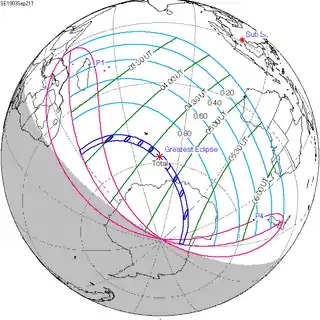 September 21, 1903 (Saros 123) |
 August 31, 1932 (Saros 124) |
 August 11, 1961 (Saros 125) |
 July 22, 1990 (Saros 126) |
 July 2, 2019 (Saros 127) |
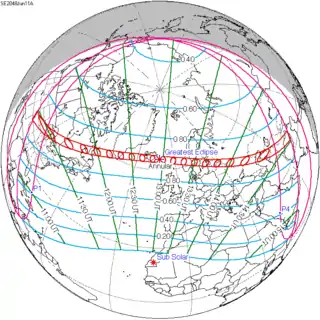 June 11, 2048 (Saros 128) |
 May 22, 2077 (Saros 129) |
||
In the 22nd century:
- Solar Saros 130: Total Solar Eclipse of 2106 May 03
- Solar Saros 131: Annular Solar Eclipse of 2135 Apr 13
- Solar Saros 132: Hybrid Solar Eclipse of 2164 Mar 23
- Solar Saros 133: Total Solar Eclipse of 2193 Mar 03
Metonic series
The metonic series repeats eclipses every 19 years (6939.69 days), lasting about 5 cycles. Eclipses occur in nearly the same calendar date. In addition, the octon subseries repeats 1/5 of that or every 3.8 years (1387.94 days).
| 22 eclipse events, progressing from north to south between April 8, 1902, and August 31, 1989: | ||||
|---|---|---|---|---|
| April 7–8 | January 24–25 | November 12 | August 31-September 1 | June 19–20 |
| 108 | 114 | 116 | ||
 April 8, 1902 |
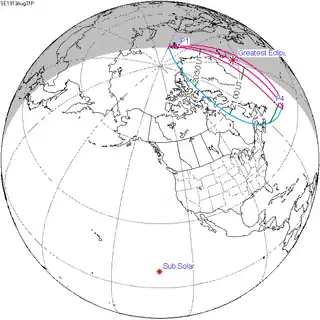 August 31, 1913 |
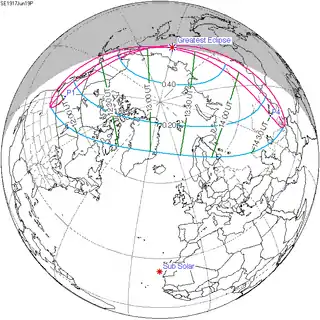 June 19, 1917 | ||
| 118 | 120 | 122 | 124 | 126 |
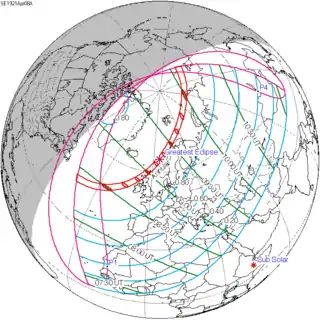 April 8, 1921 |
 January 24, 1925 |
 November 12, 1928 |
 August 31, 1932 |
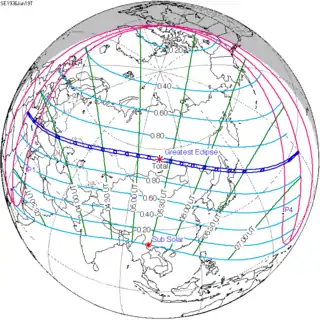 June 19, 1936 |
| 128 | 130 | 132 | 134 | 136 |
 April 7, 1940 |
 January 25, 1944 |
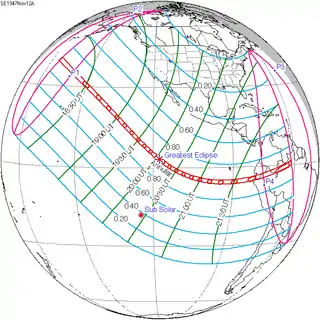 November 12, 1947 |
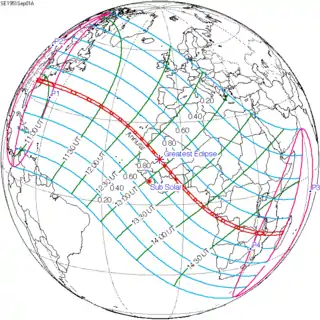 September 1, 1951 |
 June 20, 1955 |
| 138 | 140 | 142 | 144 | 146 |
 April 8, 1959 |
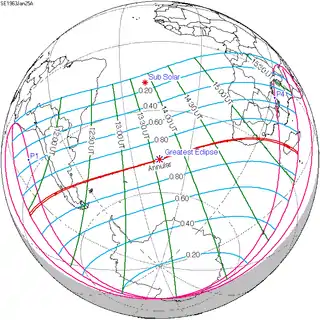 January 25, 1963 |
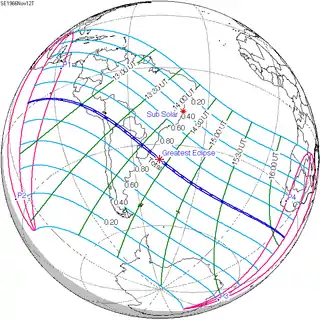 November 12, 1966 |
 August 31, 1970 |
 June 20, 1974 |
| 148 | 150 | 152 | 154 | |
 April 7, 1978 |
 January 25, 1982 |
 November 12, 1985 |
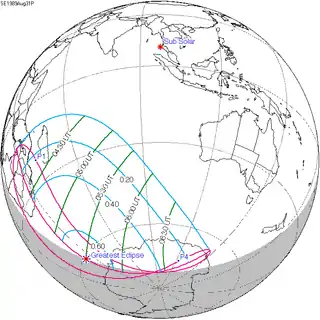 August 31, 1989 | |
Notes
- van Gent, R.H. "Solar- and Lunar-Eclipse Predictions from Antiquity to the Present". A Catalogue of Eclipse Cycles. Utrecht University. Retrieved 6 October 2018.
- Saros Series Catalog of Solar Eclipses NASA Eclipse Web Site.
References
- Earth visibility chart and eclipse statistics Eclipse Predictions by Fred Espenak, NASA/GSFC
.jpg.webp)

